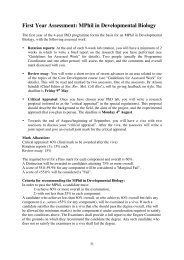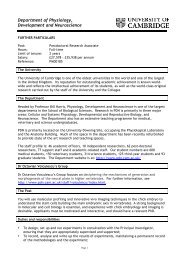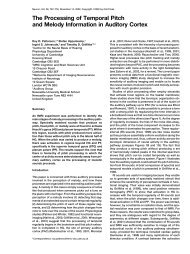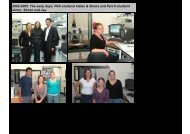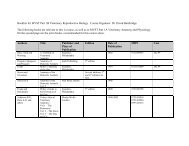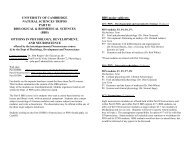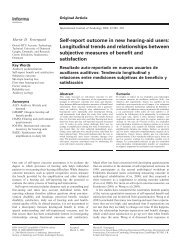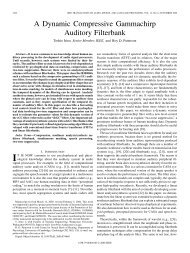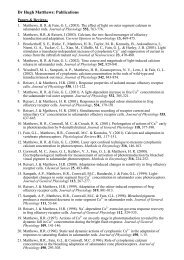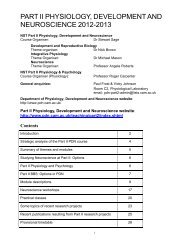FRIDAY MORNING, 20 MAY 2005 REGENCY E, 8:30 A.M. TO 12:00 ...
FRIDAY MORNING, 20 MAY 2005 REGENCY E, 8:30 A.M. TO 12:00 ...
FRIDAY MORNING, 20 MAY 2005 REGENCY E, 8:30 A.M. TO 12:00 ...
You also want an ePaper? Increase the reach of your titles
YUMPU automatically turns print PDFs into web optimized ePapers that Google loves.
4:<strong>00</strong><br />
5pBB6. Local inversion of transient shear-wave propagation for<br />
elasticity and viscosity mapping in soft tissues. Jeremy Bercoff,<br />
Mickael Tanter, and Mathias Fink Laboratoire Ondes et Acoustique,<br />
ESPCI, 10 rue Vauquelin, 75<strong>00</strong>5 Paris, France<br />
Observation of transient shear-wave propagation in soft tissue is of<br />
great interest for the study of tissue viscoelastic properties. In previous<br />
work, we introduced a technique, called Supersonic Shear Imaging SSI,<br />
able to generate transient shear waves using the acoustic radiation force<br />
and image their propagation in real time in soft tissues. In this work, a<br />
local inverse problem of the shear wave propagation permitting the recovery<br />
of shear elasticity and viscosity is presented. Compressional and shear<br />
waves are decoupled by applying the curl operator to the experimental 2-D<br />
displacement field. The role of viscosity on the accuracy of the elasticity<br />
estimation is studied. The influence of out of plane shear propagation on<br />
the inversion algorithm is discussed. Finally, in media presenting shear<br />
viscoelasticity heterogeneities, finite difference simulations are used to<br />
study the spatial resolution of the algorithm and its sensitivity to the<br />
signal-to-noise ratio. Experiments on calibrated tissue-mimicking phantoms<br />
presenting different viscoelastic properties are presented validating<br />
the simulation results. First in vivo results on female breasts are presented.<br />
<strong>FRIDAY</strong> AFTERNOON, <strong>20</strong> <strong>MAY</strong> <strong>20</strong>05<br />
<strong>REGENCY</strong> F, 1:<strong>30</strong> <strong>TO</strong> 4:45 P.M.<br />
Session 5pNS<br />
Noise and Psychological and Physiological Acoustics: Workshop on Methods for Community Noise<br />
and Annoyance Evaluation II<br />
Brigitte Schulte-Fortkamp, Chair<br />
Technical Univ. Berlin, Inst. of Technical Acoustics, Secr TA 7, Einsteinufer 25, Berlin 10587, Germany<br />
Invited Papers<br />
1:<strong>30</strong><br />
5pNS1. Auditorium Mundi soundscape in the narration of the world. Artistic and scientific aspects in the presentation of<br />
soundscapes. Harald Brandt Philippsbergstrasse 40, D-65195 Wiesbaden, Germany, haraldbrandt@yahoo.fr<br />
Auditorium Mundi is a project for the exploration and presentation of sounds and soundscapes of the whole world. The aim is an<br />
installation of a museum of audible perception in interrelation with other senses. The concept of the museum is an acoustic planetarium<br />
in which the locations of the world are put in place of the stars. Also located here are world archives for sound in which the<br />
acoustic and musical multitude of this planet will be preserved. The archives of sound are available world-wide through the internet.<br />
The museum is, at the same time, a laboratory for the development of new formats in scientific definitions and the multimedia<br />
presentation of acoustic phenomenons. It is a show-place for artistic programs and an auditorium where questions from the area of<br />
acoustic as well as new developments of industry will be accessible to a wider public. A place of innovation, where concepts for other<br />
museums, promoters and scientific institutions can be developed. The leitmotif of Auditorium Mundi is the question how man<br />
influences the soundscenes in which he lives and how strongly he himself is influenced by the noise, the resonance and the dissonance<br />
between various ways of life.<br />
1:50<br />
5pNS2. An L Aeq is not an L Aeq . Dick Botteldooren, Tom De Muer, Bert De Coensel Acoust. Group, Dept. of Information<br />
Technol., Ghent Univ., St. Pietersnieuwstraat 41, B-9<strong>00</strong>0 Ghent, Belgium, Birgitta Berglund Stockholm Univ., SE-106 91<br />
Stockholm, Sweden, and Peter Lercher Univ. of Innsbruck, A-60<strong>20</strong> Innsbruck, Austria<br />
Classical dose response relationships for environmental noise annoyance have been based on L dn or L den . These exposure<br />
measures are essentially based on an energy averaging measure, L Aeq . Differences between groups of sources e.g., continuous or<br />
event based are accounted for by using separate dose-effect relationships. In society today, one often sees that event loudness is traded<br />
for number of events which is perfectly acceptable within the L Aeq based annoyance concept. Clearly a more unified theory for noise<br />
annoyance is needed to fully account for the effect of such trade-offs. In this paper a model implementing such a theory is presented.<br />
The perceptual model starts from the premises that a sound event has to be noticed for it to contribute to overall annoyance. The model<br />
accounts for the fact that noticing a noise event not only depends on the level of the event itself but also on background noise, sound<br />
insulation and acoustic characteristics of the dwelling, level of attention, etc., the severity of the effect of a noticed sound on overall<br />
annoyance is assumed to primarily depend on the signal to noise ratio. The model allows to account for modifiers such as previous<br />
exposure, noise sensitivity, and coping. The model results are compared to the findings of a recent field experiment. Conclusions based<br />
on calculated and experimental trends will be presented.<br />
2616 J. Acoust. Soc. Am., Vol. 117, No. 4, Pt. 2, April <strong>20</strong>05 149th Meeting: Acoustical Society of America 2616



